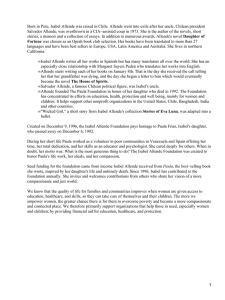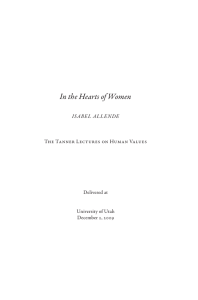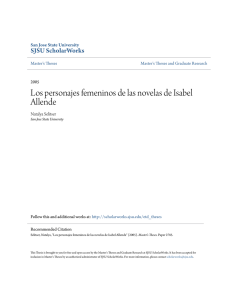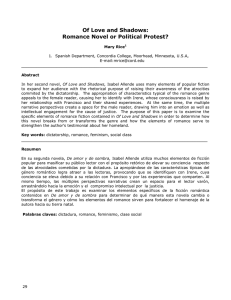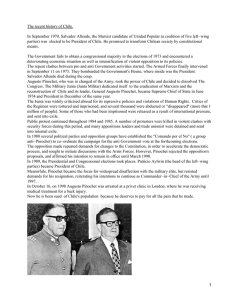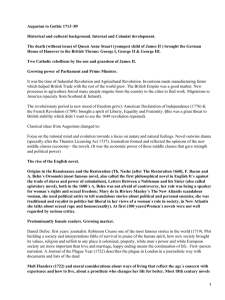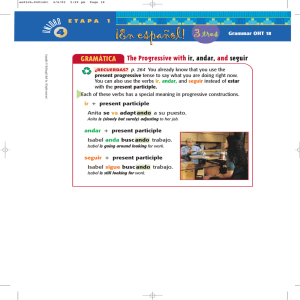Isabel Allende and Her Feminist Thoughts in Daughter of Fortune
Anuncio
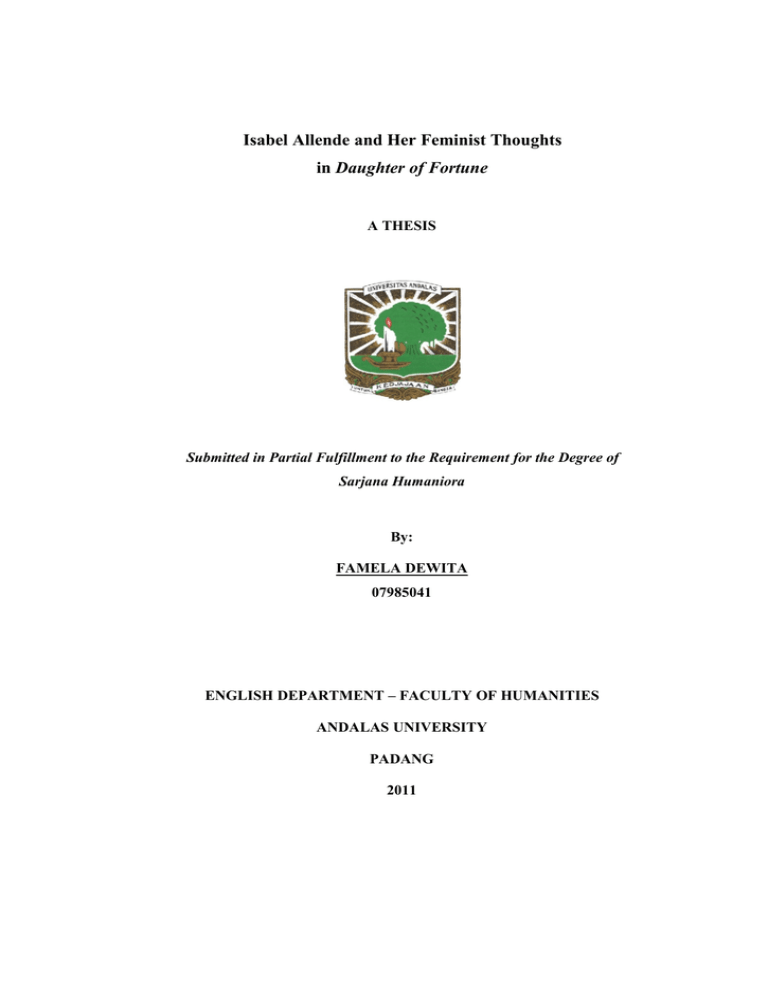
Isabel Allende and Her Feminist Thoughts in Daughter of Fortune A THESIS Submitted in Partial Fulfillment to the Requirement for the Degree of Sarjana Humaniora By: FAMELA DEWITA 07985041 ENGLISH DEPARTMENT – FACULTY OF HUMANITIES ANDALAS UNIVERSITY PADANG 2011 ABSTRAK Penelitian ini membahas novel karya Isabel Allende yang berjudul Daughter of Fortune. Penulis menganalisis pemikiran-pemikiran feminis dari Allende yang ditunjukkan melalui karakter utama wanitanya, Eliza Sommers. Dalam menganalisis novel ini, penulis menggunakan pendekatan ekspresif dan teori kritik sastra feminis, kemudian difokuskan dalam menerapkan teori ‘Gynocriticism’ yang digagas oleh Elaine Showalter. Teori ini digunakan untuk menganalisis pengalaman perempuan (woman’s experience) dalam karya sastra yang ditulis perempuan. Adapun data-data yang terkait dengan pembahasan diambil dengan menggunakan metode kualitatif dan dijelaskan secara deskriptif. Dari penelitian ini, penulis menyimpulkan bahwa Allende memberikan pemikiran-pemikiran feminisnya melalui kejadian dan pengalaman yang dilewati oleh karakter Eliza. Pemikiran-pemikiran feminis Allende itu meliputi gambaran positif tentang wanita dan juga kompetensi yang dimiliki wanita. Melalui karakter Eliza, Allende menggambarkan bahwa wanita bisa menjadi figur yang sama baiknya dengan pria, dan wanita juga memiliki kompetensi yang sama baiknya dengan kompetensi pria. Diperlihatkan bahwa pengalaman-pengalaman yang dilewati seorang wanita dapat membuat wanita menyadari kompetensi yang mereka miliki dan memunculkan kesadaran atas kekuatan yang ada di dalam diri seorang wanita. Kata Kunci: Ekspresif, Feminis, Gynocriticism, Woman’s Experience. CHAPTER I INTRODUCTION 1.1 The Background of the Research Since the feminist movement in 1960s, many women have been able to produce writings with the same quality as the men’s have. Through their writings, women are not only able to give contributions to the society but also they are able to gain appreciations and make achievements. One of the most significant female writers in contemporary literary sphere is Isabel Allende. She is known through her works, such as House of the Spirit, Daughter of Fortune, Paula and many more. She also has received many recognitions, among them are Chile's National Literature Prize in 2010, Excellence in International Literature and Arts USA in 2000, and the prestigious Dorothy and Lillian Gish Prize USA in 1998. Furthermore, she was named as Feminist of the Year by the Feminist Majority Foundation, USA in 1994. Isabel Allende was born on August 2, 1942 in Lima, Peru, and raised in Chile. She started writing since she was a teenager. She started from journalism, before she decided to write a novel in 1981 when she lived in exile in Venezuela. Most of Allende’s works are based on her personal experiences and often address the concern of the feminist issues. As Ackerman states in the article Discovering Stories that Need to be Told, “Allende’s novels often tell about love, adventure, memory and history which are filled with the strong female characters who search for love and want to find their own identities that restricted by the societies”. It indicates that Allende is a feminist who has enthusiasm and devotion to woman’s freedom. Such enthusiasm and devotion can be seen in most of her novels, including her best-selling and award winning Daughter of Fortune. Daughter of Fortune is a novel that was published in 1999 and chosen as Oprah’s Book Club selection in February 2000. This novel tells about a woman named Eliza Sommers who was adopted and raised by a family in Valparaiso, Chile. She was a woman who struggled to get her freedom since she was imposed by patriarchal dominations in her social life. The story took place during the California Gold Rush in 1849. Daughter of Fortune shows the efforts of a woman who faced a rude and chaotic world in California and finally discovered the freedom of life. Eliza’s character reflects a woman who will not follow the convention, and willing to follow her heart. Furthermore, Daughter of Fortune is classified as historical novel since it took setting in actual historical event, which is the California Gold Rush in 1849. As Barret states in an article entitled Allende joins the Gold Rush, “Daughter of Fortune is true to its billing as a historical novel, provides readers not only with romance but also many facts about a place where gold had attracted a quarter of a million immigrants in four years' time”. According to Carlos Mata Indurain in the Journal Brief Definition and Characterization of a Historical Novel, “The historical novel is a subgenre of narrative (and therefore fiction) in the construction of which certain elements and/or historical figures are included”. In brief, historical novel is a novel which deals with actual historical events. In order to make a story based on historical events, an author must know exactly about what they write, as Lundoff states in the article Historical Research for Fiction Writer, “an author of historical novel has to do historical research to provide proof of their assertions, such as, bibliographies, resource lists and notes that tell where they got the information”. (Writing-World.com) Isabel Allende is one of the historical novel writers who often does thorough historical research for her historical novels. It can be seen in most of her novels which set the past and took many historical events as the backgrounds. For instance, House of the Spirits which took setting of the World War and also Chilean earthquake which happened in 1939; and the novel Island Beneath the Sea which is set partly in late18th-century during Haitian Revolution. Since her novels tell a lot about historical events, Allende does a lot of research such as interviewing, reading books, and spending time in libraries, etc. As Allende states in the article A Teller of: Tales Isabel Allende by Anita Savio: The research I do for a book is based on interviews. If I can manage to identify a person who has lived the experience, I interview that person rather than go to something in writing… The same is true for historical novels. Although the ones I've written are set in periods from which nobody remains alive, I try to go to letters that people have written, and the more personal the letter the better. (FindArticles.com) Considering the explanation above, the writer conducts the research by using Feminist criticism since this novel has woman’s character which is believed to carry the feminist values within her. “Feminist criticism is a kind of feminist movement which analyzes literary works which deals with a woman as a subject” (Guerin 197). In addition, feminism demands equality in all aspects of life, such as in education, marriage, and social life, in order to realize that women are valuable persons and have the same rights as men. Therefore, feminist critics try to make their own type of literature and literary criticism to talk about themselves in their own perspectives. The writer will focus the analysis on the main female character, Eliza Sommers, by applying Gynocriticism (women as writer). Gynocriticism is a Feminist theory that was proposed by Elaine Showalter. It specifies in evaluating text written by woman in term of the way woman’s image is constructed or framed. The writer applies Gynocriticism since the writer believes that Allende as a female writer has her own perspectives about woman which she wants to deliver to the reader. All of the elaboration above encompasses the reasons for the writer to analyze the novel Isabel Allende’s Daughter of Fortune by using Feminist criticism. The first reason is because the novel Daughter of Fortune is a novel that tells about a woman who struggles to define the role of feminism in her life. Second, Gynocriticism as a Feminist theory is applicable for this novel, since the author of the novel is a woman and most of the critical analysis of her novel has been devoted to her feminist perspectives. Hence, the writer entitles her research Isabel Allende and Her Feminist Thoughts in Daughter of Fortune. 1.2 The Identification of the Problem The novel Daughter of Fortune tells about a woman named Eliza Sommers who first lived in Chile under patriarchal dominations which limited her social life. However, when Eliza eventually went to California and undergone a lot of new experiences, she realized that woman can also gain freedom in life. Conclusively, her experiences led Eliza to build up her awareness of feminist thoughts. From that point, it can be assumed that this novel brings the feminist issues within it. The main female character Eliza is also appropriate as the object of the analysis in order to see how the author describes her female character since she is a feminist writer. Thus, the writer will investigate the main female character of the novel in order to pile up the feminist ideas of the author. CHAPTER V CONCLUSION After analyzing Isabel Allende’s Daughter of Fortune by applying expressive theory and Gynocriticism by Elaine Showalter, the writer can conclude that there are two main points that Allende tries to share in this novel. The first main point is Allende’s positive descriptions of woman, and the second main point is Allende’s thoughts about woman’s competences. These points are shown through the main female character, Eliza Sommers. Expressive theory views literary works as the expression of the authors’ thoughts and points of view. Meanwhile Gynocriticism views the works of female authors as a mean of constructing a framework of thoughts about women by their own kind. Although Elaine Showalter provides four models of gynocriticism with different concern of areas of investigation, this study only focuses on the area of cultural aspect. Hence, the analysis evaluates the novel Daughter of Fortune as a novel which reflects Isabel Allende’s thoughts about woman based on her own experiences and the culture of the society. Through the analysis, the writer found that Allende gives at least three positive descriptions of woman through the main character Eliza, they are: woman as a strong person, woman as a smart person, and woman as an independent person. Despite of the cultural stereotype which states women are worse than men in terms of intellectuality, physical power and mentality, Allende shows that women can also perform the same capability as men and also show that both of women and men are actually equal in quality. Furthermore, Allende also shares her thoughts about women’s competences in the novel. She reveals competences of woman in three aspects. They are in travelling, cooking and writing. Despite of the society’s tendency to take for granted these competences of women, Allende believes that these competences are useful and profitable for women. In conclusion, the findings of the analysis are three positives descriptions of woman’s character and three women’s competences as shown by the character of Eliza Sommers. In addition, these points are believed to be Allende’s points of view about women. By using Gynocriticism which analyzes women’s thoughts in women’s literary works, the writer found that the experiences which women have undergone could help them to realize their competences as well as to build up their awareness of their own power. Moreover, the writer can relate the thoughts that Allende suggests in Daughter of Fortune with Allende’s personal experiences and the culture that she knows in her society. Bibliography Abrams, M.H. A Glossary of Literary Terms 4th Edition. United States of America: Norton and Peter Rushton, 1981. Print. Ackerman, Joanne Leedom. “Discovering Stories That Need to Be Told.” Isabelallende.com. Isabel Allende, 30 April 2010. Web. 24 Oct 2010. <http://isabelallende.com/ia/en/perspective/2> Allende, Isabel. Daughter of Fortune. Margaret Savers Peden, tr. New York: Harper Collins Publishers, 1999. Print. Allende, Isabel. “Musings”. IsabelAllende.com. Isabel Allende. Web. 10 June 2011. <http://isabelallende.com/ia/en/musings> Balti, Levandra. “Woman’s Self Dependence as seen in My Antonia by Willa Cather: A Feminist Study.” Padang: English Department of Andalas Unversity, 2010. Print. Barret, Sharon. “Allende Joins the Gold Rush”. IsabelAllende.com. Isabel Allende. 1999. Web. 10 June 2011. <http://isabelallende.com/ia/en/book/daughter/reviews> Barry, Peter. Beginning Theory: An Introduction to Literary and Cultural Theory. 2nd ed. Manchester and New York: Manchester University Press, 2002. Print. Bogdan, Robert C. Qualitative Research Education: An Introduction to Theory and Method. Boston: Allyin and Bacon, Inc. 1982. Print. Bressler, Charles E. Literary Criticism: An Introduction to Theory and Practice. 2nd ed. New Jersey: Prentice Hall, 1994. Print. Cox, Karen Castellucci. Isabel Allende a Critical Companion: Critical Companion to Popular Contemporary Writers. Westport, CT: Greenwood Press, 2003. Google books. Web. 24 Oct. 2010. <http://books.google.co.id/books> EasyBib.com. ImagineEasy Solutions, n.d. Web, 10 June 2011. <http://www.easybib.com/ebook> Guerin, L. Wilfred., et al. A Handbook of Critical Approach to Literature. 4th ed. New York: Oxford University Press, 1999. Print. Hasan, Rizka. A Study on Eliza Sommers’ Crisis of Identity as seen in Isabel Allende’s Daughter of Fortune. Surabaya: Petra Christian University, 2005. Web. 24 Oct 2010. Indurain, Carlos Mata. “Brief Definition and Characterization of a Historical Novel”. Culturahistorica. University of Navarra, 2009. Web. 10 June 2011. <http://www.culturahistorica.es/mata_indurain/historical_novel.pdf> Jones, Celia Tagamolila Bardwell. Travel, Home and the Space Between: A Feminist Pragmatist Approach to Transnational Identities. Diss. University of Oregon, 2007. Web. 15 Sept 2011. <https://scholarsbank.uoregon.edu/xmlui/bitstream/handle/1794/6130/Celia_B ardwell_Jones.pdf?sequence=5> Levine, Linda Gould. “Isabel Allende in Context: the Erasure of Boundaries”. Salempress.com. SalemPres, Inc, October 2010. Web. 25 October 2011. <http://salempress.com/Store/samples/critical_insights/allende_boundaries.ht m> Lundoff, Catherine. “Historical Research for Fiction Writers.” Writing-World.com. Catherine Lundoff, 2004. Web. 10 June 2011. <http://www.writing- world.com/fiction/lundoff.shtml> McMahan, Elizabeth., et al. The Element of Writing about Literature and Film. New York: Macmillan Inc. 1988. Print. Power, Margaret. “Gender and Chile’s Split Culture: Continuing Contradictions in Women’s Lives”. DRCLAS.Harvard.edu. Harvard University, 2004. Web. 25 October 2011. <http://www.drclas.harvard.edu/revista/articles/view/697> Robert, Edgar V. Writing about Literature. 9th ed. New Jersey: Prentince Hall, 2002. Print. Savio, Anita. “A Teller of: tales Isabel Allende.” FindArticles.com. CBS Interactive. Oct 2002. Web. 16 Aug 2011. <http://findarticles.com/p/articles/mi_m0PCH/is_5_3/ai_113053674/> Siegel, Dr. Kristi. “Feminism”. Web. 24 Oct 2010. <http://hs.hastings.k12.mn.us/sites/6e3486ea-9f8c-4b52-bae27be334b7418e/uploads/critical_theory_weinberg_2.pdf> Yuliandri. “The Anguish of Women under the Shadow of Patriarchal Domination as Seen in Mary Wollstonecraft’s Maria, or the Wrongs of Woman.” Padang: English Department of Andalas University, 2007. Print.
